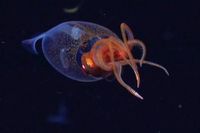In a historic moment for marine science, researchers have captured the first-ever live footage of a colossal squid in its natural deep-sea habitat. The incredible discovery was revealed on Tuesday, April 15, 2025, by the Schmidt Ocean Institute, which led an international expedition in the South Atlantic Ocean using a remotely operated underwater vehicle. The squid filmed was a juvenile, measuring about 1 foot (30 centimeters) in length, spotted at a depth of 1,968 feet (600 meters) near the South Sandwich Islands.
Until now, colossal squids have only been seen after being discovered inside the stomachs of whales or washed up on shores. This live footage marks a groundbreaking achievement for marine scientists. Researchers are now experimenting with different camera techniques, hoping to catch a glimpse of a fully grown colossal squid in its natural habitat.
A colossal squid is one of the largest and most mysterious creatures in the ocean. It is a soft-bodied sea animal, similar to an octopus but longer and bulkier. It has a tube-shaped body, huge eyes, and arms and tentacles with suckers to grab food. In the water, a squid moves by sucking in water and pushing it out like a jet, which helps it swim quickly, much like a balloon zooming around when you let the air out. Many squids can also squirt ink to escape predators, and some glow in the dark using bioluminescence.
Young colossal squids are almost completely transparent, making them look like jelly. As they grow, they turn a dark red or purple color. Fully grown, they are believed to be the largest invertebrates on Earth, meaning they have no bones but can still grow to massive sizes. This recent sighting gives scientists hope of learning more about these elusive deep-sea giants and possibly finding an adult one alive in the ocean someday.
Marine biologists have finally checked off one of the field's most tantalizing near-term scientific milestones. Using a remotely operated vehicle (ROV), they've captured the first-ever confirmed footage of a colossal squid in its natural habitat, 2,000 feet under the ocean's surface. Schmidt Ocean Institute (SOI), which owns and operates the research vessel Falkor (too), announced the groundbreaking achievement on April 15, 2025.
On March 9, an international team of researchers sent SuBastian, the vessel's ROV, into the South Atlantic Ocean near the South Sandwich Islands. At a depth of 1,968 feet, SuBastian spotted a baby squid swimming gracefully through the cold, dark water. Kat Bolstad, a marine biologist at New Zealand's Auckland University of Technology who specializes in the glass squid family, later confirmed that the creature in the footage was Mesonychoteuthis hamiltoni—the highly elusive colossal squid.
The hooks toward the middle of its eight arms distinguished the squid from Galiteuthis glacialis, the glacial glass squid. At 30 centimeters (11.8 inches) long, the subject of SuBastian's footage is definitely a juvenile. Colossal squids are "estimated to grow up to 7 meters (23 feet) in length and can weigh as much as 500 kilograms (1,100 pounds), making them the heaviest invertebrate on the planet," says SOI.
But few details are known about the colossal squid's maturation from juvenile to adult, other than that it will lose its transparent appearance as it ages. Scientists have previously only seen colossal squid in the stomachs of whales and seabirds, and by then, the squid weren't exactly thriving. Previous attempts to image the squid in their natural habitat have presumably scared the species away, Bolstad told NPR: Their large eyes are sensitive to light, and they might avoid noisy research equipment.
This means this footage offers the first real peek at how the species conducts its day-to-day life. "It’s exciting to see the first in situ footage of a juvenile colossal and humbling to think that they have no idea that humans exist," Bolstad said.
This is one of many exciting scientific achievements to have occurred on or alongside Falkor (too). SOI says that on January 25, another expedition captured the first confirmed footage of the glacial glass squid, another species that had never been seen in its own habitat. Earlier this month, researchers aboard the vessel accidentally discovered a hidden Antarctic ecosystem under a calved chunk of the George VI Ice Shelf. And last year, biologists working on Falkor (too) identified 100 new marine species and four underwater mountains during a single expedition off the coast of Chile.
The implications of this discovery are profound. As scientists continue to explore the depths of the ocean, they hope to uncover more about the behaviors and habitats of elusive creatures like the colossal squid. Understanding these giants could also shed light on the broader ecosystem dynamics in deep-sea environments.
With this new footage, researchers are not only excited about the colossal squid but also about the potential to learn more about other mysterious marine life. The ocean remains one of the least explored frontiers on Earth, and each new discovery adds a piece to the puzzle of understanding our planet's biodiversity.
This groundbreaking achievement showcases the importance of ongoing marine research and the technological advancements that make such discoveries possible. As the Schmidt Ocean Institute continues its explorations, the hope is that more mysteries of the deep sea will be unveiled, providing insights that could lead to further scientific breakthroughs.





